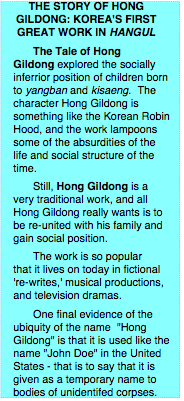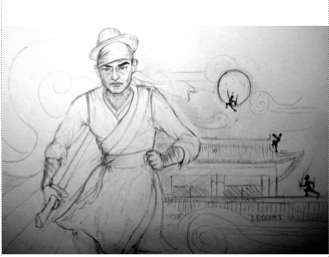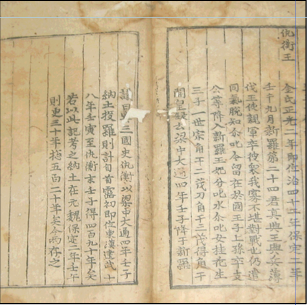Because of the strong emphasis on oral tradition and poetry as literature, classical Korean written literature is rare. While the oral and poetic traditions date back to the Silla period, classical written fiction appears relatively late in the Joseon Dynasty. There are a few written records predating the 12th century, so we can date the start of Korean classical prose from this time. It began with historical records, notably the History of the Three Kingdoms (Samguk Sagi), the collection of which was was orchestrated by Goryeo’s King Injong (1122-1146). Another work of note was created by Buddhists: The Tripitaka Koreana collects the Buddhist scriptures in the form of woodblock carvings. Finally, the Samguk Yusa collects legends, biographies, anecdotes, and folktales from a variety of sources and across multiple dynasties.
The Korean Novel in General
 Korean novels of all eras have a slightly different look and feel than in the west as the form of the Korean novel (the sosol) includes short stories, novellas, and novels, and the differences in length can be quite dramatic with some ‘novels’ clocking in at under 40 pages (Park Min-gyu’s brilliant Dinner with Buffett is an excellent example of this scarcely clocking in at 30 pages in its English translation, but nonetheless published as an individual work in translation) and other novels being produced in massive multi-volume collections e.g. (Park Kyung-ni’s Land which checked in at 16 volumes in Korean and is only partially translated into English). Some critics speculate that this Korean focus on, and reverance for the short story is a reflection of the original Korean preference for oral poetry, many forms of which were quite short (Pansori, obviously, excluded)?
Korean novels of all eras have a slightly different look and feel than in the west as the form of the Korean novel (the sosol) includes short stories, novellas, and novels, and the differences in length can be quite dramatic with some ‘novels’ clocking in at under 40 pages (Park Min-gyu’s brilliant Dinner with Buffett is an excellent example of this scarcely clocking in at 30 pages in its English translation, but nonetheless published as an individual work in translation) and other novels being produced in massive multi-volume collections e.g. (Park Kyung-ni’s Land which checked in at 16 volumes in Korean and is only partially translated into English). Some critics speculate that this Korean focus on, and reverance for the short story is a reflection of the original Korean preference for oral poetry, many forms of which were quite short (Pansori, obviously, excluded)?
Classic literature began with the Tales of Kumo (Kumo Shinwa, or New Stories from the Golden Turtle) Kim Shi-sup in the mid 15th century and The Story Of Hong Gildong attributed to Hyo Kyun in the late 16th or early 17th century. Indicating the language split that still existed in literature, Tales of Kumo was written in Chinese while The Story of Hong Gildong was written, or at least recorded, in Hangeul. Not surprisingly, the latter work has had more of a lasting impact on Korea. These works also began to move away from the tightly biographical / mediative / philosophical and to directly deal with social conditions. An entirely new form of fiction, the ‘family soap opera” also appeared around this time. These stories covered multiple generations, a format still popular in Korea from Three Generations in 1931 to Please Look After Mom in 2009. Many of these works were serialized, and thus began to extend the the range of settings, characters and narratives of the fiction, thus removing some of the solipsism that had previously characterized Korean fiction. This kind of work is still popular within Korean, even today it is known as taeha sosòl (“great-river fiction”). However, because of its length, it is not that amenable to translation. Three Generations, for instance, was serialized in the Chosun Ilbo, not entirely published in even Korean until the 50’s and arriving at a novel length of an alarming 432 pages, when translated into English.
From the 17th century on written literature became more popular and a larger reading  public developed. Later, as commercial publishing developed in Korea, book rental operations did brisk business. Subject matter expanded to include attacks on, and ridicule of, current social problems. As the parable-based nature of fiction decreased, thhe potential cast of characters and topics increased. Characters of ‘lower’ social status, of mercantile nature, criminals, and even kisaeng, began to populate literature.
public developed. Later, as commercial publishing developed in Korea, book rental operations did brisk business. Subject matter expanded to include attacks on, and ridicule of, current social problems. As the parable-based nature of fiction decreased, thhe potential cast of characters and topics increased. Characters of ‘lower’ social status, of mercantile nature, criminals, and even kisaeng, began to populate literature.
These diversions were no doubt hastened by, and at least accompanied by, an increasingly large number of works being created in Hangeul. While The Story of Hong Gildong is the most notable, these works also included Lady Sa’s Southward Journey (18th century) and Kim Man-jung’s The Cloud Dream of the Nine (17th century). These were widely read by women and common men. Other fictions of the late Joseon Dynasty were concerned with proceedings of the court, including Record of Leisurely Feelings (1795-1895) and Queen Inhyon’s Story. As these works were being written, Hangeul. spread throughout society, beginning at the bottom and working its way up.
The Story of Hong Gildong is a Korean classic of family betrayal, adventure and eventually a kind of reunion and, thankfully, after years of only being easily available in children’s-story versions, is now in reprint and available on Amazaon. This book has been a staple of Korean culture since its publication, having been ‘translated’ into video, television, related novels, children’s stories, comic books, and even a musical. The main character, Hong Gildong, is the extremely talented illegitimate son of government functionary. His own father is persuaded that Hong Gildong should be killed, cannot find a place in the formal society of the time, so he runs away and becomes an outlaw who battles evil, murderers, and the government, eventually creating his own kingdom and demonstrating high levels of filial piety despite his circumstances. As noted in the sidebar, the name of “Hong Gildong” is so ubiquitous in Korean society that it is the temporary name given to unidentified corpses in Korea, just as “John Doe” is used to name the unidentified dead in the United States.
The Cloud Dream of the Nine by Kim Manjung is also available from Amazon. This early novel is s story of competing ambition and faith, as well as a love story. Putatively the story of of a youth traversing two different lives in the company of eight maidens, it was written in the Tang Dynasty, and explores a historical competition at the time, that between the religion Buddhism and the ethical system Confucianism, the two main pillars of Korean philosophy, and two that often found each other in opposition. This seminal work was translated by James Garth Scale in 1922 (re-issued in 2003). Author Kim Manjung wrote the novel while on the road in exile, supposedly to distract his understandably upset mother, and it went on to become a Korean classic, partly, like “Hong Gildong” because it was translated into Hangeul (the language of the original version is pretty clear to be Chinese, an issue which causes some critics pain in calling it part of “Korean” literature).
Unfortunately, the true extent of the classic novel may never be completley known, as most of them did not survive their era.. Kim Hunggyu notes that the one-time existence of some six hundred classic novels existed and that they were divided amongst heroic novels, fantasy dream novels, historical war novels, pansori novels, family novels, and novels still in classical Chinese(109). Hong Gildong, of course, is among the “hero” novels, and The Cloud Dream of the Nine is among the dream variety. Pansori novels included the Tale of Ch’unhyang, the Tale of Shim Cheong, and the Tale of Hungbu.the Tale of Hungbu has lived on in various forms, including as a chidlren’s book available on Kindle, On Hungbu and Nolbu, as a drama and theater, and even on a set of stamps released 1969/70.
As the Classical Era wound down with the weakening of the Joseon dynasty and a brief “Enlightenment” began to develop, ideological and physical forces marshaled themselves to invade Korea, but the groundwork for Korean modern literature was being laid. The land, so to speak was being prepared, both psychologically and technologically, and soon political realities were to intervene in unexpected and distorting ways.



